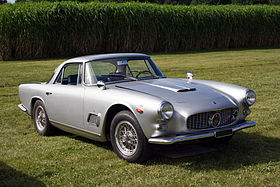Maserati 3500
| Maserati 3500 GT | |
|---|---|
 |
|
| Overview | |
| Manufacturer | Maserati |
| Production | 1957–1964 |
| Designer |
Carrozzeria Touring (coupé) Giovanni Michelotti at Vignale (spyder) |
| Body and chassis | |
| Class | Grand tourer (S) |
| Body style |
2+2 coupé 2-seat spyder |
| Layout | Front-engine, rear-wheel-drive |
| Related | Maserati Sebring |
| Powertrain | |
| Engine | 3.5 L Tipo 101 I6 |
| Transmission | 4-speed ZF S4-17 manual 5-speed ZF S5-17 manual |
| Dimensions | |
| Wheelbase | 2,600 mm (102.4 in) (coupé) 2,500 mm (98.4 in) (spyder) |
| Length | 4,780 mm (188.2 in) (coupé) 4,450 mm (175.2 in) (spyder) |
| Width | 1,760 mm (69.3 in) (coupé) 1,635 mm (64.4 in) (spyder) |
| Kerb weight | 1,440 kg (3,175 lb) |
| Chronology | |
| Predecessor | Maserati A6 |
| Successor | Maserati Sebring |
The Maserati 3500 GT (Tipo 101) and the Maserati 3500 GT Convertibile (Tipo 101/C) are 2-door coupé and convertible grand tourers made by Italian car manufacturer Maserati between 1957 and 1964. It was a seminal vehicle for Maserati as the company's first successful attempt at the Gran Turismo market and series production.
In the early 1950s Maserati had achieved racing success and international visibility, thanks to cars such as the A6GCM; its 2-litre, twin cam inline-six engine had already been enlarged to three litre capacity on the Maserati 300S. Chief engineer Giulio Alfieri felt the next step was to design an all-new 3.5-litre engine; the resulting long-stroke six, designed foremost for endurance racing on the Maserati 350S, was ready in 1955. In the meantime Maserati's first forays into the grand tourer market, the 1947 A6 1500, 1951 A6G 2000 and 1954 A6G/54, had proven that the business was feasible; but the A6 road cars were still built in just a dozen examples a year—hardly series production. A different approach was needed to build fully accomplished grand tourers.
The main development efforts that led to the 3500 GT were carried out in 1956–57, despite the frantic activity required by Maserati's participation in the Formula 1 world championship. Alfieri modified the 350S's engine to suit a touring car, e.g. by switching to a wet sump oil system and changing the engine accessories. He also made several business trips to the United Kingdom in order to contact components suppliers. None were found in Italy, as Italian taxation system and the industry structure forced manufacturers to design every part in-house; an daunting task for small companies like Maserati. Thus the 3500 GT alongside Italian Weber carburettors and Marelli ignition, used many British-made components such as a Salisbury rear axle, Girling brakes and Alford & Alder suspension parts.
...
Wikipedia
